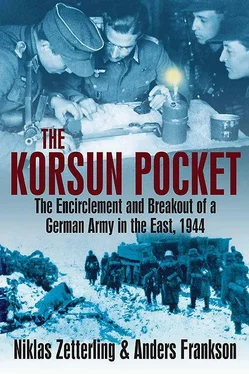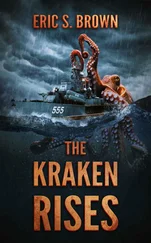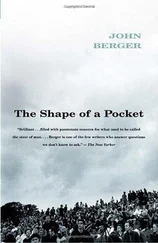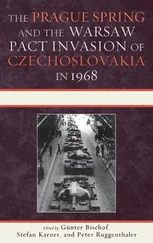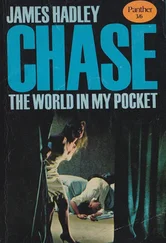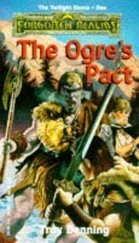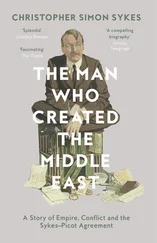At the beginning of August, Bessonov arrived at the headquarters of the Bryansk Front, from where he was passed on to the 4th Tank Army, which needed replacements. At first Bessonov spent two weeks without seeing any action, but in the middle of August the company he belonged to was sent forward to attack. Bessonov was given command of the 2nd Platoon and had very little time to get acquainted with the men subordinate to him before the fighting began. 10
After moving up in the evening, Bessonov and his unit was ready to attack in the morning. Bessonov’s company formed a line in order to advance toward a hill, together with two other companies from the battalion. They did not know whether the hill was defended by the Germans or not, but the truth soon dawned upon them. Enemy machine guns opened fire on the advancing Soviet infantry and then the Germans launched a mortar barrage. Bessonov, as he had been trained, shouted: “Forward, run!”
Except for himself, nobody followed Bessonov’s order. He looked around and saw that his men had taken cover in a ravine and begun to dig in. Bessonov decided to follow their example, only to realize that he lacked equipment for the job. Fortunately he could borrow an entrenching tool from a soldier who had been quick to dig a hole for himself. 11
The day passed and another attack was attempted during the night, but it failed too. On the following day, a further attempt was to be made and this time Bessonov warned some of the soldiers that if they did not advance in the attack, they would be severely punished for cowardice. He even told one of his subordinates, who had claimed a stomach ache as a reason for not following the attack, that he would be shot if it happened again. Such threats were, however, to little avail, as the attacks during the second day also failed. Even tank support from three T-34s was ineffective. 12
On the third day the Soviet attack was suspended, as the positions held by Bessonov and his men were subjected to repeated German air strikes and artillery barrages. The Soviet soldiers hunkered down in their foxholes while shell after shell, bomb after bomb, exploded around them and sent splinters whizzing around the area. Bessonov later recalled that in a hell such as that to which he was subjected, time passes painfully slowly. Toward the end of the day the German fire ceased and Bessonov’s unit could count its losses. 13
Bessonov’s baptism of fire was not remarkable for the men who served on the Eastern Front. The vast number of casualties necessitated a huge influx of green replacements, especially for the Red Army. Millions of men must have experienced their first combat action during the second half of 1943, and come to realize how terrifying war could be. Bessonov was one of those fortunate enough to survive the war and retell his experiences.
The War on the Eastern Front, August–November 1943
During the last three months of 1943 the costly battles continued, as fighting along the Dnepr River ensued. Soviet casualties diminished slightly, but were nevertheless very high. German losses also declined somewhat, but still exceeded the Reich’s capability to replace them. 14
In essence the war in the east during the second half of 1943 was a war of attrition. The Red Army did not cause German defenses to collapse in an operational sense; rather it succeeded in exerting sufficient pressure to push the Germans back gradually. The latter succeeded in extracting a disproportionally high toll on the attackers and, as argued above, it was only thanks to the equally exceptionally large advantage in reinforcements and replacements that the Red Army could maintain the pressure. An important factor explaining the poor casualty exchange ratio was the absence of major encirclements of German units. If German units could be surrounded, the Red Army would stand a much better chance of achieving a favorable casualty exchange ratio. However, encirclements had been difficult to achieve for the Red Army, since the Soviet forces thus far had not been able to advance quickly enough to prevent the Germans from withdrawing in relatively good order.

Although the cost in manpower was extremely high, the Red Army had made important gains. A considerable part of Ukraine had been liberated, with its valuable economic, agricultural and industrial assets. But to what extent these could be exploited was yet unclear, as the Germans had made extensive efforts to destroy industrial plants and infrastructure, remove or kill livestock, and deport part of the population, particularly those able-bodied men who could be used as labor or for military service. 15
Of the Soviet victories thus far, Stalingrad stood out as the most complete. Not only did the Germans suffer considerable losses, their losses were also distributed among all arms. This was a major difference compared to the fighting in the second half of 1943, when German losses were mainly confined to the infantry. This made it easier for the Germans to replace casualties. Furthermore, as long as German forces were not cut off, wounded men typically made up 70–80% of the casualties. 16Of these, almost half could be expected to return to duty within a period of time that was not inordinately long, but sometimes several years could pass before a wounded soldier returned to frontline service. Anton Meiser had served in the 79th Infantry Division in 1940, when he had been seriously wounded. After more than five months in various hospitals, he was declared capable of garrison duty. Almost three years passed while he served mainly in Metz and Nancy in eastern France. During this period he performed various office tasks, but the deteriorating situation on the Eastern Front mandated changes. 17
The 389th Infantry Division had been destroyed at Stalingrad, but it was decided that it should be reconstituted and the remnants assembled in western France. Far too few men remained from the original division. Most of the manpower of the new formation would not be veterans of the old one, and Meiser was one of the men detailed to the new 389th Division. He was to serve in the 389th’s artillery regiment, and late in August 1943 he arrived at the unit’s base in western France. 18
An autumn in France would perhaps have been a pleasant sojourn, but Meiser’s lot was different. After a month with his unit, Meiser and his new comrades were loaded on trains, as was the equipment and horses. They could only speculate on what the future would bring them, but when they had reached well into the Soviet Union, the train stopped as there had been a partisan attack on the station they were to pass. The partisans had already disappeared, but the dead bodies of the railway staff remained as a sombre remainder of what could happen to anyone serving on the Eastern Front. 19
The three years that passed between Meiser’s being wounded in 1940 and his return to frontline duty was probably a longer period than most wounded German soldiers experienced. His example does, however, show something that probably was typical: the longer the period of convalescence, the less chance of returning to the original unit.
With the Germans driven out of the eastern Ukraine, and Soviet armies reaching the eastern bank of the Dnepr, it was evident that the Germans were losing their grip in the East. Also, in September Allied forces had invaded mainland Italy. Mussolini had already been arrested in the wake of the Allied invasion of Sicily, and the Allied landings at Salerno caused Italy to change sides in the war. Other German allies were to follow suit and try to get out of the war, or change sides, but the diminishing successes did not shake Hitler’s resolve to continue fighting. Most of Italy was promptly occupied by German forces, and as poor weather in the English Channel area could be expected to prevent an Allied seaborne operation, Hitler decided to send some Panzer divisions from western Europe to the Ukraine, where the Soviet offensives continued.
Читать дальше
